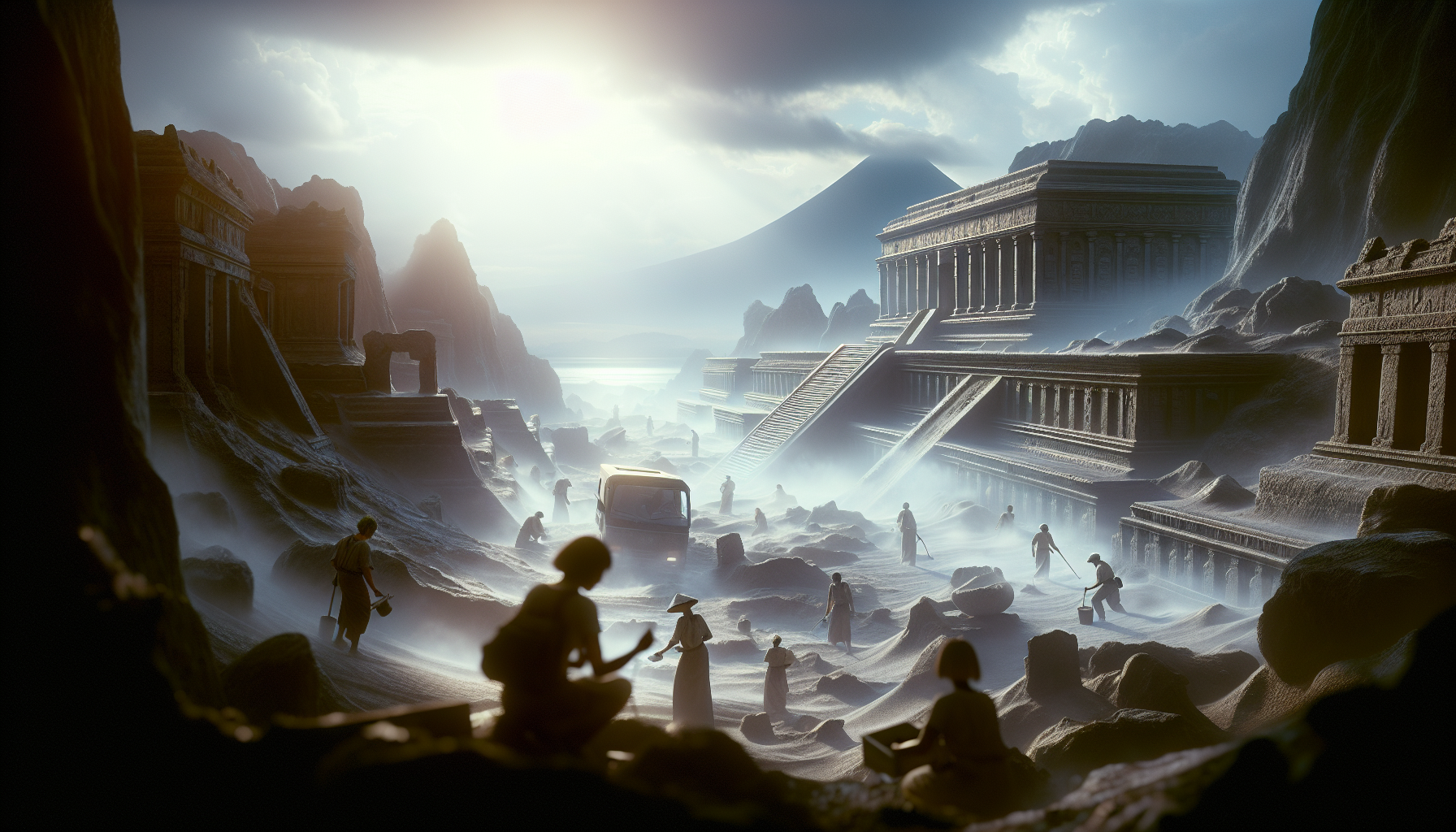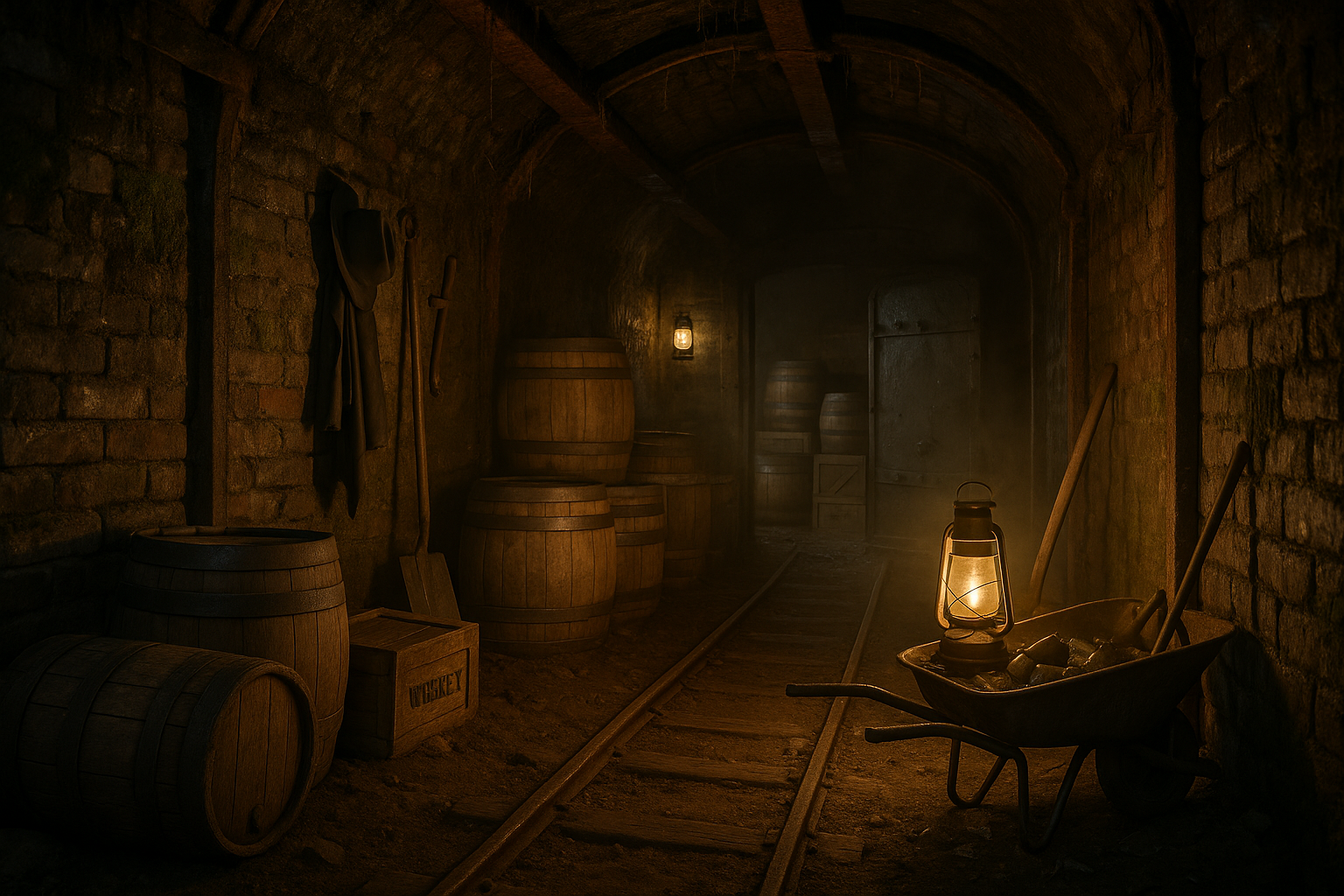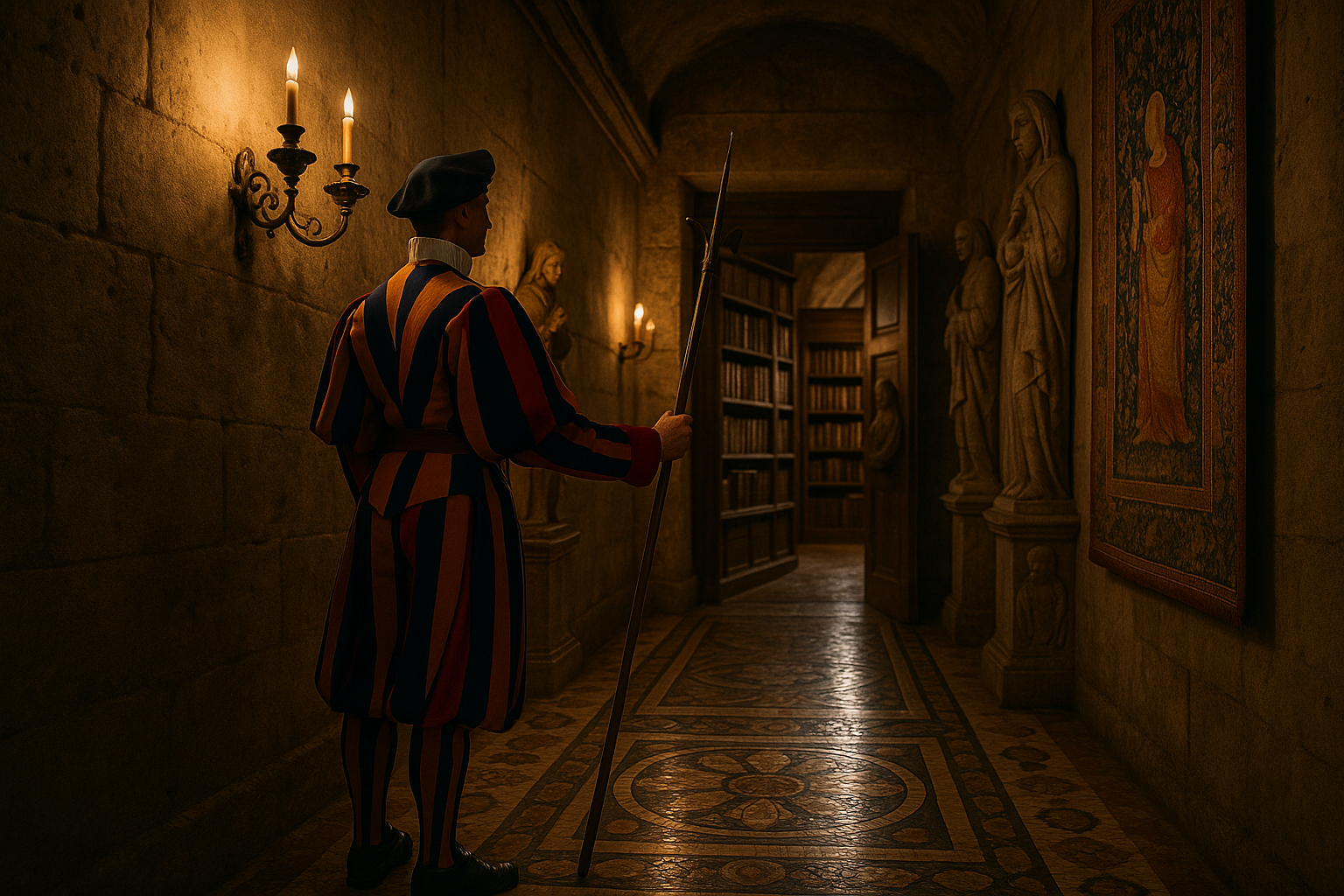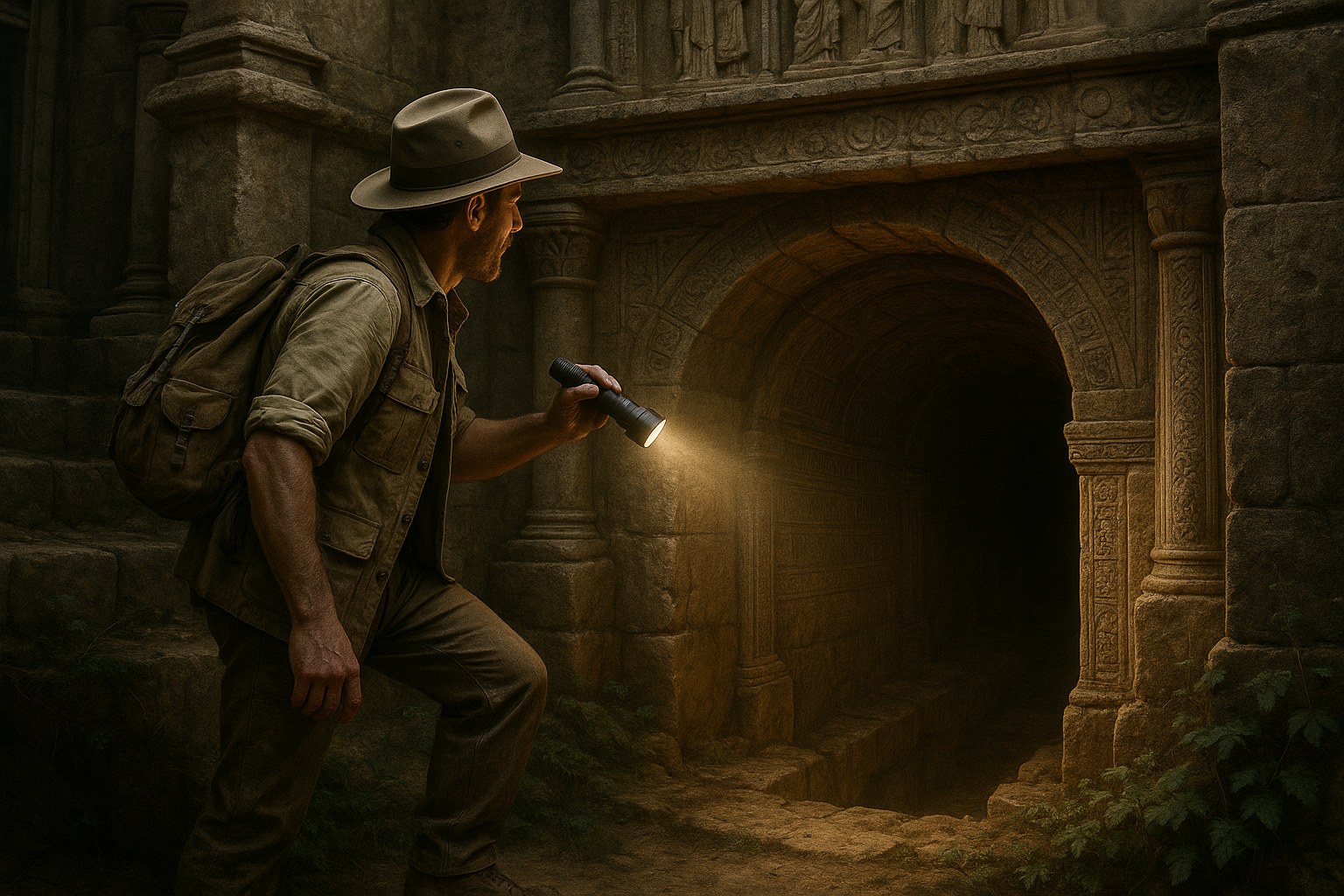In a world brimming with bustling cities and towering skyscrapers, it is easy to forget that beneath our feet lie remnants of civilizations long lost to time. These forgotten cities, once vibrant and full of life, now slumber beneath layers of earth and ash, waiting to be unearthed. Among the myriad forces of nature capable of erasing a civilization in the blink of an eye, volcanic eruptions stand out as one of the most cataclysmic. They are both creators and destroyers, forging new land while burying the old. 🌋 In this article, we embark on a journey to explore the enigmatic world of cities lost to volcanic fury, where history and mystery intertwine in a dance as ancient as the Earth itself.
The concept of cities lost to volcanic eruptions is as fascinating as it is chilling. Imagine, for a moment, living in a thriving metropolis, unaware of the impending doom rumbling beneath the earth. Suddenly, without warning, the ground trembles, and the sky darkens with ash, heralding the eruption of a nearby volcano. The devastation is swift and unforgiving, as pyroclastic flows engulf the city, preserving it in a fiery tomb. This terrifying scenario has played out numerous times throughout history, leaving behind a legacy of mystery and intrigue that continues to captivate archaeologists and historians alike.
Among the most famous of these lost cities is Pompeii, the Roman city frozen in time by the eruption of Mount Vesuvius in 79 AD. Pompeii serves as a poignant reminder of nature’s power, its well-preserved ruins offering a unique glimpse into the daily lives of ancient Romans. However, Pompeii is just the tip of the iceberg when it comes to volcanic burial. Throughout the world, from the Americas to Asia, numerous other cities have met similar fates, each with its own story to tell. Our exploration will take us beyond the well-trodden paths of Pompeii to uncover lesser-known sites that have similarly been swallowed by volcanic fury.
In our journey, we will delve into the science behind volcanic eruptions, understanding how these natural phenomena occur and why they can be so devastating. We will examine the different types of eruptions and their potential to obliterate entire communities. This scientific foundation will allow us to appreciate the delicate balance between human civilization and the forces of nature, highlighting the precariousness of life in the shadow of a volcano. 🏞️ As we uncover the past, we will also consider the lessons these lost cities hold for contemporary society, particularly in terms of disaster preparedness and resilience.
Finally, we will explore the ongoing efforts to excavate and preserve these buried cities. Archaeologists and researchers employ cutting-edge technology and innovative methods to peel back layers of ash and uncover the stories hidden beneath. These endeavors not only deepen our understanding of ancient cultures but also ignite the imagination, reminding us of the resilience of the human spirit. As we journey through time, uncovering the mysteries of cities lost to volcanic burial, we invite you to reflect on the fragility and wonder of human existence, and the enduring quest to connect with those who came before us.
The Allure of Lost Cities: A Dive into History
Throughout history, the concept of lost cities has fascinated both scholars and enthusiasts alike. These cities, often buried under layers of earth and history, offer a glimpse into ancient civilizations that thrived and then disappeared. The reasons for their disappearance vary from natural disasters to wars and sometimes mere abandonment. However, one of the most intriguing phenomena is the burial of cities due to volcanic eruptions. This natural occurrence has preserved many cities in a time capsule, offering insights into daily life centuries ago. But what exactly makes these cities so intriguing? The allure lies in the mystery, the stories untold, and the potential to uncover hidden knowledge.
Lost cities buried by volcanic activity are particularly fascinating due to the rapid and catastrophic manner in which they were covered. Unlike cities that decayed over time, those covered by volcanic ash and lava were often preserved in remarkable detail. The volcanic material can encase structures, objects, and even organic matter, creating a unique snapshot of a particular moment in history. As excavations progress, archaeologists and researchers uncover artifacts that shed light on the social, economic, and cultural practices of the time. These findings are invaluable, providing a tangible connection to our past and allowing us to piece together the stories of those who came before us.
Furthermore, the study of these buried cities contributes significantly to our understanding of the impact of natural disasters on human settlements. By examining the evidence left behind, scientists can develop better strategies for predicting and mitigating the effects of future volcanic eruptions. This interdisciplinary approach, combining archaeology, geology, and history, not only enriches our knowledge of the past but also equips us with tools to protect our future.
Pompeii: The Iconic Volcanic Burial
One of the most famous examples of a city buried by volcanic activity is Pompeii. Located near modern-day Naples in Italy, Pompeii was a thriving Roman city before it was buried under volcanic ash following the eruption of Mount Vesuvius in 79 AD. The eruption was sudden and catastrophic, engulfing the city in a thick layer of ash and preserving it almost perfectly for nearly 1,700 years until its rediscovery in the 18th century.
The significance of Pompeii lies in its well-preserved state, which offers an unprecedented glimpse into Roman life. From the architecture to the artifacts, each aspect of the city tells a story of its inhabitants. Homes, shops, and public spaces remain intact, complete with frescoes, mosaics, and everyday objects, all frozen in time. This preservation allows researchers to study various aspects of Roman culture, from urban planning to dietary habits. In addition, the casts of human and animal figures found in Pompeii provide poignant reminders of the tragedy that befell the city’s inhabitants, caught unaware by the eruption.
| Aspect | Details |
|---|---|
| Location | Near Naples, Italy |
| Date of Eruption | 79 AD |
| Preservation | Volcanic ash |
| Rediscovery | 18th century |
For a visual journey through Pompeii, check out the video below from the National Geographic channel:
Lost World of Pompeii – National Geographic
Herculaneum: The Lesser-Known Neighbor
While Pompeii often takes the spotlight, the nearby city of Herculaneum also offers a wealth of information and insight into the lives of ancient Romans. Unlike Pompeii, Herculaneum was buried under a much thicker layer of volcanic material, which has preserved even organic materials such as wood and food. This unique preservation allows archaeologists to study a different aspect of Roman life that is not as evident in Pompeii.
The city of Herculaneum was a smaller, wealthier community compared to Pompeii, and its preservation offers a different perspective on Roman society. The homes in Herculaneum are larger and more luxurious, with intricate frescoes and mosaics that speak to the affluence of its residents. Additionally, the preservation of wooden furniture and even food items such as loaves of bread provides a more intimate look at the daily lives of its inhabitants. This level of preservation is rare and offers a more comprehensive understanding of Roman domestic life.
One of the most significant discoveries in Herculaneum is the Villa of the Papyri, a grand residence believed to have been owned by the father-in-law of Julius Caesar. This villa housed an extensive library, with many scrolls preserved by the volcanic material. Although much of the library remains unreadable due to the fragile nature of the scrolls, advancements in technology hold the promise of unlocking these ancient texts in the future, potentially offering new insights into Roman philosophy and literature.
| Aspect | Details |
|---|---|
| Location | Near Pompeii, Italy |
| Size | Smaller than Pompeii |
| Wealth Level | Higher than Pompeii |
| Preservation | Thicker volcanic material |
If you’re intrigued by Herculaneum and its unique story, consider watching the following video by Discovery UK:
Herculaneum: A City Frozen in Time – Discovery UK
The Role of Technology in Excavating Lost Cities
In recent years, technological advancements have revolutionized the field of archaeology, particularly in the study of lost cities buried by volcanic activity. From satellite imagery to 3D modeling, these tools have enabled researchers to explore sites in greater detail without causing damage to fragile structures. This non-invasive approach is crucial in preserving the integrity of these historical sites while uncovering valuable information.
One of the most significant advancements is the use of LiDAR (Light Detection and Ranging) technology, which allows archaeologists to map out buried structures with incredible accuracy. By analyzing the way light bounces off surfaces, LiDAR can create detailed topographical maps that reveal hidden structures beneath the earth. This technology has been instrumental in uncovering previously unknown sites and providing a clearer understanding of known cities.
Additionally, 3D modeling and virtual reality (VR) offer immersive experiences that bring these ancient cities to life. Researchers can create detailed reconstructions of sites, allowing both scholars and the public to explore them in ways that were previously impossible. These models not only aid in research but also serve as educational tools, making history accessible to a broader audience.
- Satellite imagery: Offers a bird’s-eye view of large areas, identifying potential excavation sites.
- LiDAR: Provides detailed mapping of underground structures without excavation.
- 3D modeling: Reconstructs sites for study and educational purposes.
- Virtual reality: Creates immersive experiences of lost cities.
To see how technology is transforming archaeology, watch the following video by SciShow:
How Technology is Uncovering Ancient Cities – SciShow
The Future of Lost Cities: Preservation and Exploration
As interest in lost cities continues to grow, so does the importance of preservation. While uncovering the mysteries of these ancient sites is crucial, ensuring their longevity for future generations is equally important. Conservation efforts must balance the need for research with the responsibility to protect these invaluable historical treasures.
Organizations worldwide are working to preserve and protect these sites through various initiatives. This includes monitoring environmental conditions, preventing looting, and promoting sustainable tourism practices. By raising awareness and fostering a sense of stewardship, these efforts aim to ensure that lost cities remain accessible and informative for generations to come.
Moreover, the continued development of technology will likely play a significant role in future discoveries and preservation efforts. As techniques become more refined and accessible, the potential for uncovering new sites and preserving existing ones grows exponentially. This dynamic field promises to yield exciting developments and deepen our understanding of the past, offering a glimpse into the rich tapestry of human history.
Join the conversation on the future of archaeology by watching this insightful video by TEDx Talks:
The Future of Archaeology – TEDx Talks

Conclusion
In conclusion, the exploration of “Lost Cities: Uncovering the Mysteries of Volcanic Burial” has provided us with a profound understanding of how nature’s formidable forces have shaped human history and culture. Throughout this article, we have delved into the fascinating tales of ancient civilizations that were abruptly buried by volcanic eruptions, leaving behind a wealth of archaeological treasures. From Pompeii’s remarkably preserved ruins to the enigmatic remnants of Akrotiri, these cities offer invaluable insights into past societies’ daily lives, architectural prowess, and cultural practices.
One of the main points highlighted in our discussion is the incredible preservation conditions created by volcanic ash. This natural phenomenon acts as both a destructive and preservative force, encapsulating entire cities and thus providing modern archaeologists with unique opportunities to study them in unparalleled detail. For instance, Pompeii, frozen in time since AD 79, offers a snapshot of Roman life, with its frescoes, buildings, and even the poignant plaster casts of its inhabitants. Similarly, the Minoan civilization of Akrotiri has been uncovered with its vibrant wall paintings and sophisticated infrastructure, offering clues to the complexity and advancement of this Bronze Age society.
Another critical aspect we examined is the technological advancements that have revolutionized archaeological research. Techniques such as ground-penetrating radar, 3D reconstructions, and other modern excavation tools have enabled researchers to explore these buried cities with minimal disturbance. These innovations not only aid in unearthing hidden structures but also in preserving them for future study and public education.
The stories of these lost cities also underscore the ever-present interplay between humans and their environment. They serve as a potent reminder of the power of natural disasters and the resilience of human spirit and ingenuity in the face of such challenges. The rediscovery of these cities has not only filled gaps in historical narratives but has also sparked a renewed interest in preserving our shared heritage.
Reflecting on the broader implications of these archaeological findings, we are reminded of the importance of interdisciplinary collaboration in uncovering and interpreting the past. Historians, archaeologists, geologists, and many other experts work together to piece together the puzzles left behind by these ancient catastrophes. This collaborative effort enriches our understanding and appreciation of ancient cultures and underscores the necessity of preserving these sites for future generations.
As we close this exploration into the mysteries of cities lost to volcanic fury, it is crucial to recognize the relevance of these findings in today’s context. They provide valuable lessons on urban planning, disaster preparedness, and cultural preservation. By learning from the past, contemporary societies can better prepare for future challenges posed by natural disasters.
In light of this, we encourage you, our readers, to reflect on the intricate relationship between human civilization and the environment. Consider how the lessons learned from these ancient tragedies can be applied to modern challenges. Share this article with others to spread awareness about the importance of archaeological research and heritage preservation. Engage in discussions and contribute your thoughts and insights, as collective knowledge and dialogue are powerful tools in fostering a deeper understanding and appreciation of our world’s rich history.
We hope this journey through time has inspired you to appreciate the resilience of the human spirit and the enduring legacy of past civilizations. 🌋🏛️ May it motivate you to explore further, question more deeply, and contribute to preserving the stories that define our shared humanity. For further reading and exploration, consider visiting reputable sources such as [Archaeology Magazine](https://www.archaeology.org) and [National Geographic](https://www.nationalgeographic.com) to stay updated on the latest discoveries in the field. Thank you for joining us on this expedition into the heart of lost cities, where history sleeps beneath layers of ash and earth, waiting to be rediscovered.
Toni Santos is a visual storyteller and artisan whose work explores the quiet power of what lies beneath. With a deep fascination for subterranean and hidden architecture, Toni uncovers the layers, voids, and forgotten spaces that shape our built environment from the shadows.
His art is a journey through the unseen — from ancient underground chambers to sealed passageways, service tunnels, and foundations buried in time. Each creation tells a story of silence, secrecy, and structure — revealing how absence and concealment can be just as meaningful as what’s visible above ground.
Whether working through visual compositions, architectural studies, or symbolic handcrafted pieces, Toni captures the soul of hidden spaces. His work bridges art and archaeology, blending design with discovery. Trained in visual design and traditional techniques, Toni creates with intention. His pieces don’t just depict — they interpret, inviting viewers to rethink what space, memory, and architecture mean when they’re hidden from view.
As the creative force behind Vizevex, Toni shares this perspective through curated visual narratives, symbolic collections, and interpretive essays that give voice to the quiet geometries beneath our feet.
His work is a tribute to:
The mystery of spaces built to be forgotten
The symbolism embedded in foundations, voids, and passageways
The timeless connection between human intention and hidden structure
Whether you’re an artist, an urban explorer, or someone fascinated by the unseen frameworks that support our world, Toni invites you into a realm where architecture becomes myth — one corridor, one layer, one buried story at a time.





